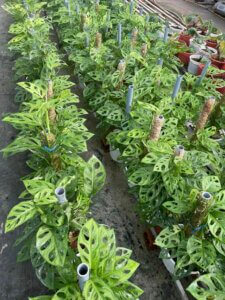Basic Information
This guide will explore the Monstera Adansonii, a beautiful and well-liked houseplant admired for its unique perforated leaves. Our aim is to assist you in comprehending and mastering the art of taking care of your Monstera Adansonii, making sure that it flourishes and enhances the tropical charm of your home.



Light
Monstera Adansonii flourishes in bright, indirect light. It can tolerate lower light conditions but may grow slower and produce fewer leaves. Avoid direct sunlight, as it can scorch the leaves. A north or east-facing window is ideal, providing ample light without the harshness of direct sun. If you notice the leaves reaching out or the plant becoming leggy, it might be a sign to move it closer to a light source.
Water
For a healthy Monstera Adansonii plant, make sure to let the top inch of soil dry out before watering it again. Overwatering can cause root rot, so it’s better to underwater than overwater. During winter, when growth slows down, reduce the frequency of watering. If the leaves droop or curl, it’s a sign that the plant needs water. Compared to Deliciosa, Monstera Adansonii requires more watering due to its thinner leaves.
Soil
This plant thrives in a well-draining, peat-based potting mix. Adding elements like perlite or orchid bark can enhance soil aeration and drainage, simulating the plant’s natural epiphytic habitat. This mix will help keep the roots healthy by providing the necessary balance of air and moisture.
Tip: Choose potting soil without moisture crystals and let it dry out before soaking.
Temperature
Monstera Adansonii grows best in a warm and stable environment, with temperatures ranging between 18°C to 27°C (65°F to 80°F). Avoid exposing the plant to sudden temperature changes or drafts, which can stress the plant and impede growth.
Humidity
This plant loves high humidity levels, ideally between 60% to 80%. You can increase humidity around the plant using a humidifier, misting regularly, or placing the pot on a pebble tray filled with water. High humidity helps maintain the lush appearance of the leaves and promotes healthy growth.
Tip: Try grouping your indoor plants closer to increase the humidity in the air.
Fertilizer
Houseplants thrive when fertilized regularly during their active growing season, typically in the spring and summer months. You should use either ¼-diluted fish emulsion with iron or ¼-diluted complete liquid fertilizer twice a month to ensure that your plants receive the necessary nutrients. Alternatively, you can top-dress your plants in the spring with compost, such as worm castings. This method slowly releases nutrients to the roots throughout the growing season. During the dormant winter months, you should reduce fertilizing to every other month or stop altogether. It’s important to avoid over-fertilizing your plants, as this can cause damage. Therefore, make sure to follow the instructions carefully.
Growth Rate
Monstera adansonii is a fast-growing plant that can reach heights of 12 feet or more indoors when provided with the right conditions. It may slow down or pause its growth during colder months. To encourage vertical growth, providing support like a trellis or moss pole can be helpful.
Pet Safety
Monstera Adansonii is toxic to pets. Keep it out of reach to avoid accidental ingestion.
Grow in Semi-Hydro
- Monsteras, known for their robust growth and iconic split leaves, flourish in semi-hydroponics systems like LECA/Pon, thanks to their adaptive root systems and love for moisture.
- Transitioning Monstera to semi-hydroponics is effective with a Nutrient Stagnant Wicking (NSW) setup, ensuring a stable and efficient growth environment.
- In LECA/Pon, Monstera roots quickly adjust, overcoming any initial challenges with root adaptation in the NSW system.
- A nutrient mix with a concentration of about 800-1000ppm is ideal for fertilizing Monsteras in semi-hydro setups.
- Monsteras are adaptable to various temperature and humidity conditions, making them suitable for growth in diverse indoor environments.
- Ongoing care includes regular monitoring of the water level in the reservoir and periodic flushing of the system to promote healthy and continuous growth.
Tips
- Rotate your Monstera regularly to ensure even growth on all sides.
- Clean the leaves with a damp cloth to improve photosynthesis.
- Inspect regularly for pests like spider mites and treat them promptly if needed.
- Repot every 2-3 years to refresh the soil and accommodate growth.
- Support your plant with a moss pole or trellis as it grows taller.
Caring for a Monstera Adansonii requires balance in light, water, and humidity. Consistent and patient care is crucial for its thriving. Enjoy the tropical vibe it adds to your indoor garden.
Happy planting! 🌱


